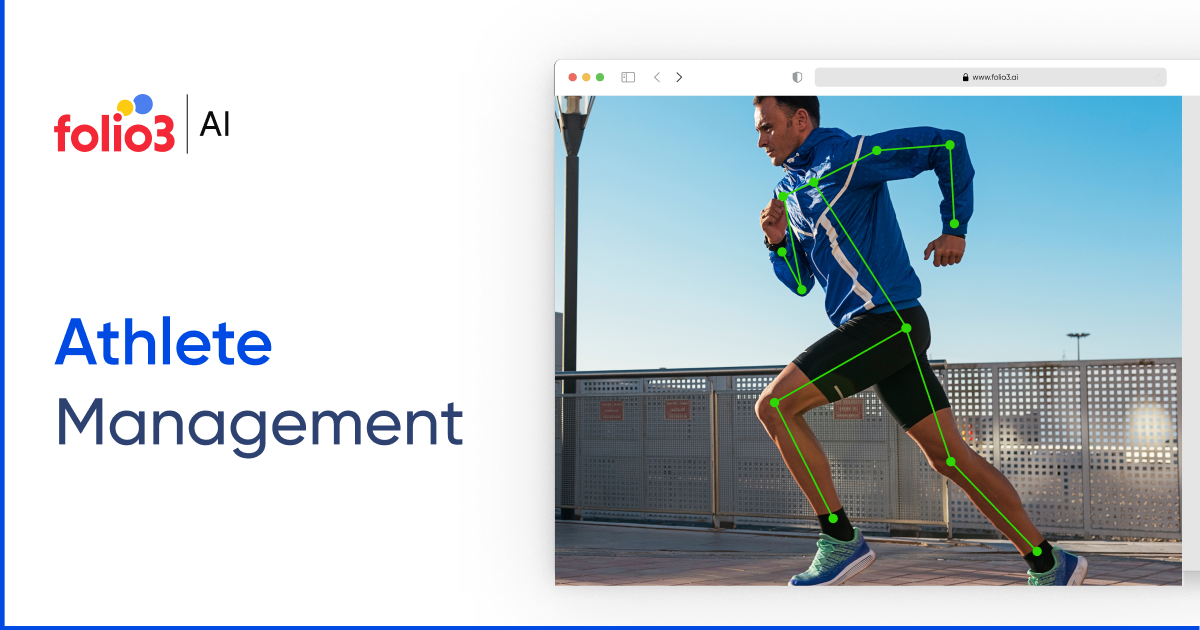Granular and insightful data is essential for excelling in sports, as it forms the foundation for intelligent decision-making on and off the field. Likewise, effective athlete management depends on detailed analysis of key movements and weaknesses, enabling precise interventions that drive consistent improvement and peak performance.
AI-powered sports Video Analysis has become a transformative tool in this process, as it can instantly process vast amounts of footage, extract key performance metrics, and provide real-time feedback on player movements, tactics, and physical condition capabilities that far surpass traditional manual analysis.
It helps deconstruct key factors to help coaches deeply analyze each athlete’s behavior and pattern, such as
- Movement efficiency and biomechanics
- Fatigue levels and recovery needs
- Performance consistency and trends
- Injury risk indicators
- Tactical positioning and decision-making
- Skill execution under pressure
Ensure each athlete receives support tailored to their unique strengths and weaknesses. In this blog, we explore the full spectrum of how these AI-powered sports Video Analysis applications reshape athlete management in different sports, offering a deep dive into their functionalities, benefits, and real-world impact.
The Foundation of Athlete Management
Effective athlete management is built on a holistic approach that balances several key components.
- Physical Training and Performance Tracking: Tailored training programs and real-time performance tracking ensure athletes are optimizing their training and progressing toward their goals. This is closely tied to sports video analysis, which breaks down movements and technique, allowing for detailed performance insights and adjustments.
- Nutrition, Recovery, and Wellness Planning: Proper nutrition and recovery strategies fuel athletes’ bodies, allowing them to perform at their best. Video analysis supports this by identifying inefficient movement patterns that may strain muscles, ensuring recovery efforts focus on the right areas.
- Psychological Coaching and Mindset Development: Mental toughness and focus are as important as physical training. Sports video analysis helps with mental conditioning by allowing athletes to review successful moments, build confidence, and learn from mistakes.
- Injury Prevention and Rehabilitation Workflows: Video analysis plays a pivotal role in injury prevention by identifying biomechanical flaws that could lead to strain or injury. Post-injury, it helps track recovery, ensuring that athletes return to peak performance safely.
Role of Sports Video Analysis in Athlete Management
Sports video analysis is integral to the foundational elements of athlete management. Its incorporation of these core pillars makes it a powerful real-time technology for comprehensive athlete management.
- Physical Training and Performance Tracking offer a detailed view of an athlete’s technique, allowing for precise adjustments in training to improve efficiency and avoid injury.
- Nutrition, Recovery, and Wellness: Video analysis helps detect improper form that might lead to strain by analyzing movement patterns. This ensures athletes focus on recovery protocols that target vulnerable areas.
- Psychological Coaching and Mindset: Video footage provides mental reinforcement by showcasing successes and helping athletes visualize improvement, which enhances motivation and focus.
- Injury Prevention and Rehabilitation: It identifies biomechanical risks and monitors progress during rehabilitation, ensuring athletes are recovering without pushing beyond their limits.
7 Steps to Success in Athlete Management
Achieving sustained success in athlete management requires a structured, data-driven approach. Below are the key steps to guide you through the process:.
1. Baseline Assessment
Assess an athlete’s fitness, skill level, and health metrics, including strength, endurance, flexibility, and any existing injuries, to establish a comprehensive starting point. Video analysis is an essential tool for evaluating techniques and identifying areas of improvement from the outset.
2. Goal Setting
Set short-term and long-term goals based on the athlete’s needs and baseline assessment. These could range from improving specific skills to preparing for an upcoming competition. Goals should be measurable and realistic, and video analysis can provide a benchmark to track progress.
3. Data Collection & Integration
Gather data using various tools like sports video analysis, GPS tracking, and biometric sensors (heart rate, speed, etc.). Video analysis offers detailed insights into technique, while GPS and biometric tools monitor physical performance, creating a holistic picture of the athlete’s capabilities and needs.
4. Actionable Insights
Review collected data and video footage to uncover areas where performance can be improved. Use these insights to create personalized training plans that target specific weaknesses or optimize strengths. This step ensures that every workout is aligned with the athlete’s objectives.
5. Iterative Feedback Loop
After each training session or competition, analyze performance data and video footage to provide immediate feedback. Make adjustments to training plans in real-time based on the data, allowing for continuous refinement and ensuring the athlete is constantly evolving.
6. Cross-functional Collaboration
Collaborate with coaches, analysts, physiotherapists, and nutritionists to ensure all aspects of the athlete’s development are aligned. Coaches and analysts focus on performance, physiotherapists manage injuries and recovery, and nutritionists tailor diet plans. Regular communication ensures the athlete’s needs are being met from every angle.
7. Review & Optimize
Conduct regular monthly assessments to track progress, identify any stagnation, and optimize strategies. Adjust training, recovery, or nutrition plans as needed to ensure continuous growth. Use video analysis to compare current performance against previous benchmarks and refine the approach accordingly.
Sport-Specific Athlete Management Applications
Athlete management strategies vary significantly across different sports, requiring tailored approaches to optimize performance. Here’s how sports video analysis and data integration are used across various disciplines.
1. Football
- Tactical Analysis of Formations and Positioning: Video analysis is used to study team formations, player positioning, and movement patterns. This helps in refining team strategy and improving on-field decision-making.
- Individual Player Heatmaps and Movement Efficiency: Heatmaps track player movements during games to identify areas of efficiency or inefficiency. This data helps coaches optimize individual roles and movement strategies.
- Integration with HUDL and GPS Data for Training Feedback: Video footage is integrated with GPS and biometric data to provide comprehensive feedback during training, focusing on player performance, stamina, and tactical execution.
2. Baseball
- Pitching and Batting Mechanics Breakdown: Sports video analysis allows for in-depth breakdowns of pitching motions and batting stances, helping players refine their techniques and reduce the risk of injury.
- Reaction Time and Fielding Agility Through Frame-by-Frame Analysis: Video analysis of fielding drills helps improve reaction time and fielding techniques by breaking down each play into detailed frames.
- Scouting Reports and Opponent Tendencies: Analyzing footage of opposing teams provides valuable insights into their playing styles, allowing players and coaches to develop more effective game plans.
3. Basketball
- Shot Trajectory, Release Time, and Court Coverage Analysis: Video analysis is used to evaluate shot mechanics, including release time and trajectory, to improve shooting accuracy. Court coverage analysis helps players optimize their movements during offense and defense.
- Load Management Using Biometric and Motion Data: By integrating video analysis with biometric data, coaches can track players’ workload, monitor fatigue, and optimize rest and recovery.
- Video Feedback for Play Calling and Defensive Rotations: Coaches use video analysis to review plays, refine strategies, and adjust defensive rotations for maximum efficiency during games.
4. Cricket
- Bowling Action Analysis and Injury-Risk Evaluation: Video analysis is crucial in assessing bowling actions to ensure proper technique, minimizing injury risks. Bowlers can adjust their actions based on visual feedback.
- Batting Stance Optimization and Ball-Tracking Insights: Batting techniques are reviewed through video analysis, optimizing stances and improving shot selection. Ball-tracking technologies help analyze the trajectory and timing of deliveries.
- Use of Hawk-Eye and Other Technologies for Fielding Reviews: Hawk-Eye technology and other video tools are used to analyze fielding positions and player reactions, helping to fine-tune fielding strategies.
5. Swimming
- Underwater Video Analysis for Stroke Technique: Underwater footage assesses stroke techniques, ensuring swimmers maintain optimal form and efficiency in the water.
- Start, Turn, and Finish Breakdown: Video analysis helps refine the swimmer’s start, turn, and finish techniques, all of which are critical for shaving seconds off race times.
- Monitoring Lactate Levels and VO2 Max Alongside Video: Coaches can better understand how fatigue and endurance impact technique and overall performance by combining video analysis with biometric data like lactate levels and VO2 max.
The End
Winning a championship isn’t just about playing hard. It’s about really understanding the game — and more importantly, the players. They’re the real strength behind every win. That’s why we need data — not just numbers on a sheet, but real insights. And this is where sports video analysis changes everything. It lets us slow things down, see what’s working, what’s not, and how each player is moving, reacting, and performing.
It’s like having a second pair of eyes that never blink. When we use that kind of analysis, we’re not guessing anymore — we’re making smart, focused decisions that lead to real results.

Manahil Samuel holds a Bachelor’s in Computer Science and has worked on artificial intelligence and computer vision She skillfully combines her technical expertise with digital marketing strategies, utilizing AI-driven insights for precise and impactful content. Her work embodies a distinctive fusion of technology and storytelling, exemplifying her keen grasp of contemporary AI market standards.









